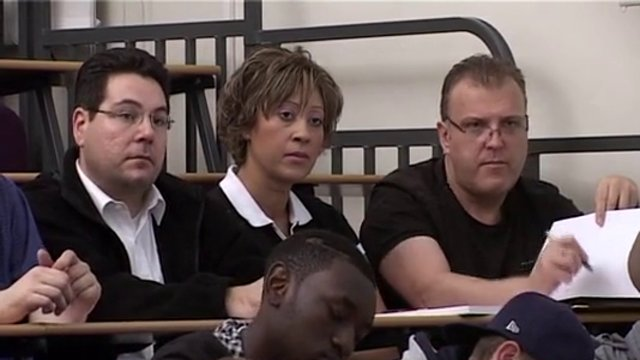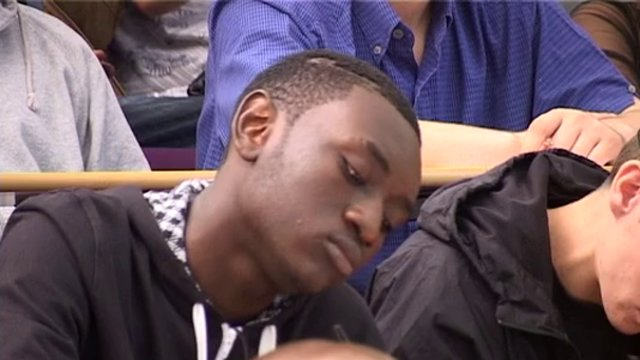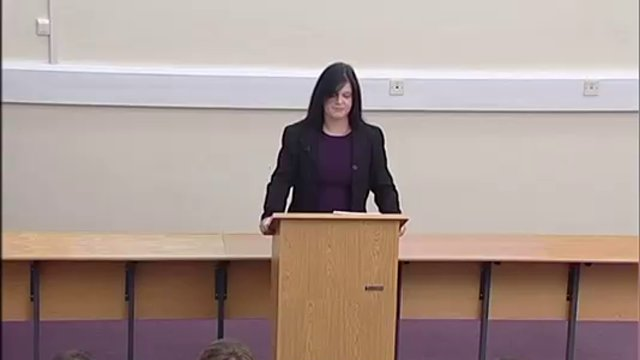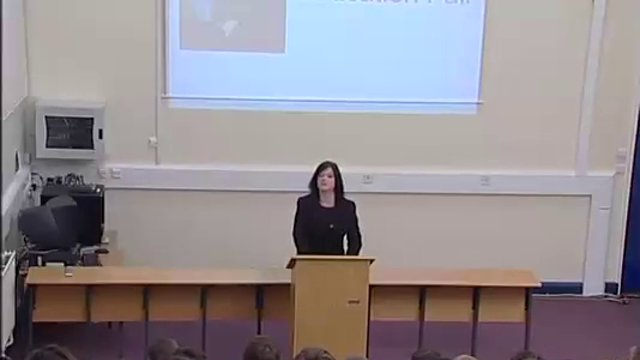
Unit 2, Video 1 – Leading in to a presentation (Exercise 2.1)
Click here for supplementary interactive exercises
In my presentation this morning, I’m going to talk about some famous British inventors and the products that they developed. Basically, I’ve divided this presentation into three parts. In the first part, I’ll talk about Alexander Graham Bell and the invention of the telephone. Then, in the second part, I’ll look at the work of John Logie Baird and his development of the television. And to finish off, I’ll discuss Alexander Fleming and his research on the antibiotic we now know as penicillin. So let’s start by looking at …

Unit 2, Video 2 – Presentation about the IELTS exam (Exercise 3.1)
Good morning, everyone and welcome to the Fair. It’s a real pleasure to see so many people taking part. My name is Lisa Thompson and I’m a senior manager with the British Council here in Hong Kong. As I think you know, we hold this Information Fair every year for Hong Kong students planning to study in the UK. And in this first presentation today, I’m going to talk about the most common English Language entry qualification recognized by British universities – the International English Language Testing System, perhaps better know as the ‘IELTS’ examination. Basically, I’ve divided my presentation into four parts. I’ll start by looking at the history of IELTS and I’ll tell you a bit about its background. Then, in the second part, I’ll give you an overview of the examination format and look at how the different skills are actually tested. In part 3, I’ll be focusing on IELTS scores and what they mean. And finally, in the last part of my presentation today, I’ll say a little about some of the problems with IELTS. So, let’s start then, by looking at the history and background of IELTS. The test was first developed in 1989 and its purpose, as I am sure you all know, was and indeed still is, to measure a student’s ability to communicate in English when their ultimate goal is to study or work where English is the main language of communication … (FADE OUT)
Now, I’d like to move on to the second part of my presentation today, the IELTS examination format. As I mentioned earlier, the exam aims to test each of the four skills and this is reflected in the format of the paper. Students taking the IELTS exam first sit papers in listening, reading and writing – these must be completed in one day – and they then have a speaking paper in the form of a short interview. However, what you may not know is that there are actually two different versions of IELTS – a test for General English and a test for Academic English … (FADE OUT)
This leads us to my third point – how to interpret IELTS scores. IELTS scores are based on nine different bandings, ranging from Expert Users in band 9 down to Non-Users in band 1. The different scores for each separate component of the exam are added together to make a final total. For most British universities and colleges, the critical IELTS bands are between 6 and 7 as these are the ones used to measure whether or not a student can join a degree course directly, without having to go through an English Language Foundation Programme … (FADE OUT)
Now I’d like to move on to the final part of my presentation today and talk about some of the problems with IELTS … (FADE OUT)

Unit 2, Video 3 – Linking points in the presentation body (Exercise 3.1)
Click here for supplementary interactive exercises
Good morning, everyone and welcome to the Fair. It’s a real pleasure to see so many people taking part. My name is Lisa Thompson and I’m a senior manager with the British Council here in Hong Kong. As I think you know, we hold this Information Fair every year for Hong Kong students planning to study in the UK. And in this first presentation today, I’m going to talk about the most common English Language entry qualification recognized by British universities – the International English Language Testing System, perhaps better know as the ‘IELTS’ examination. Basically, I’ve divided my presentation into four parts. I’ll start by looking at the history of IELTS and I’ll tell you a bit about its background. Then, in the second part, I’ll give you an overview of the examination format and look at how the different skills are actually tested. In part 3, I’ll be focusing on IELTS scores and what they mean. And finally, in the last part of my presentation today, I’ll say a little about some of the problems with IELTS.

Unit 2, Video 4 – Linking points in the presentation body (Exercise 3.1)
Part 1
So, let’s start then, by looking at the history and background of IELTS. The test was first developed in 1989 and its purpose, as I am sure you all know, was and indeed still is, to measure a student’s ability to communicate in English when their ultimate goal is to study or work where English is the main language of communication …

Unit 2, Video 5 – Linking points in the presentation body (Exercise 3.1)
Part 2
Now, I’d like to move on to the second part of my presentation today, the IELTS examination format. As I mentioned earlier, the exam aims to test each of the four skills and this is reflected in the format of the paper. Students taking the IELTS exam first sit papers in listening, reading and writing – these must be completed in one day – and they then have a speaking paper in the form of a short interview. However, what you may not know is that there are actually two different versions of IELTS – a test for General English and a test for Academic English …

Unit 2, Video 6 – Linking points in the presentation body (Exercise 3.1)
Part 3
This leads us to my third point – how to interpret IELTS scores. IELTS scores are based on nine different bandings, ranging from Expert Users in band 9 down to Non-Users in band 1. The different scores for each separate component of the exam are added together to make a final total. For most British universities and colleges, the critical IELTS bands are between 6 and 7 as these are the ones used to measure whether or not a student can join a degree course directly, without having to go through an English Language Foundation Programme …

Unit 2, Video 7 – Linking points in the presentation body (Exercise 3.1)
Part 4
Now I’d like to move on to the final part of my presentation today and talk about some of the problems with IELTS …

Unit 2, Video 8 – Lead-in phrases (Exercise 4.1)
Click here for supplementary interactive exercises
a) OK, let’s start by looking at where paper was actually invented.
b) So, for starters, let’s look at the history of the telephone.
c) Now, I’d like to move on to the next part of my presentation, which is how Hitler got the support of the German people.
d) Next, I’d like to look at my second point today: some of the ways in which mobile phone technology has developed.
e) This leads us to my next point: suggestions for improving your English speaking.
f) Right, I’m going to finish off today by looking at Alexander Fleming and the antibiotic penicillin.
g) This brings us to the final part of my presentation today: what countries can do to reduce their greenhouse gas emissions.
